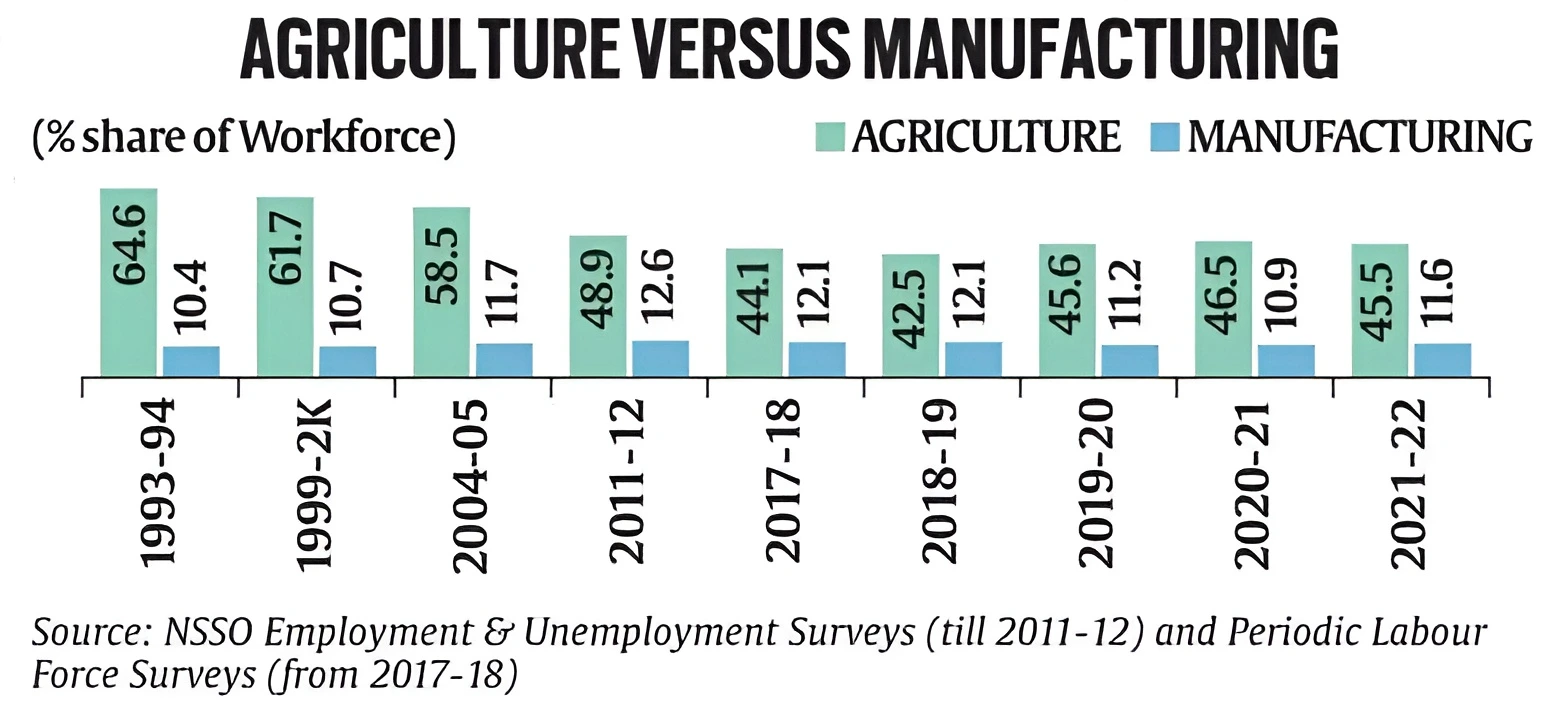Context:
- This article is based on the news “There is no easy escape from the middle income trap” Which was published in the Mint. World Bank chief Economist ‘Indermit Gill’ recently commented that Middle-income countries like India need to make policies based on reliable data to get into the league of high-income nations in the next 3-4 decades as achieving sustainable growth will become more challenging.
| Relevancy for Prelims: Middle Income Trap, Middle income countries, World Bank, India’s GDP Growth Rate, Insolvency and Bankruptcy Code (IBC), and Per Capita Income of India.
Relevancy for Mains: Middle Income Trap, Reasons for the middle income trap, India’s Path to Developed Economy by 2047, How has India moved up the development ranks, challenges for India’s high economic growth, and strategies to escape middle income traps. |
India’s Path to Developed Economy: Aiming for 8% Growth by 2047
- Going forward, economic growth will get more complicated for middle income countries like India, not easier. He pointed out that relatively few countries (31) have grown into high-income countries between 1990 and 2021.
- The success stories of transformation to high-income status include Japan, Taiwan, South Korea, Portugal, Poland and Latvia.
- India needs to achieve a growth rate of 8% to become a developed economy by 2047, according to World Bank’s latest India Development Update (IDU).
How does World Bank classify countries based on income?
The World Bank assigns the world’s economies to four income groups—low, lower-middle, upper-middle, and high income. The classifications are updated each year on July 1 and are based on the GNI per capita of the previous year. GNI measures are expressed in United States dollars (USD).
Classifications can change for two reasons:
- Changes to Atlas GNI per capita: In each country, macro economic indicators influence the level of Atlas GNI per capita. Revisions to improve national accounts estimates and methods can also have an impact
- Changes to classification thresholds: To keep income classification thresholds fixed in real terms, they are adjusted annually for inflation using the Special Drawing Rights (SDR) deflator,
- A weighted average of the GDP deflators of China, Japan, the United Kingdom, the United States, and the Euro Area. For example the below table shows data for the year financial year 2023.

What is the middle income trap?
- A middle income trap is a scenario where the country’s economy cannot transition to higher per-capita income levels.
- Low wages, cheap labour, and basic technology catch-up help low-income countries transition faster to middle-income levels.
- Getting from $1,000 per capita to $10,000 is more complicated than getting from $100 to $1,000, which relies on low labour costs and more jobs.
Case Study: India loses competency in T-shirt exports against Vietnam and Bangladesh.
- India’s cost of manufacturing in T-shirt is bit higher than what Bangladesh offers to the brands.
- Average per T-shirt export price in 2022 was for India-US $ 2.69 and Bangladesh- US $ 2.60.
- While, Vietnam has required raw material, expertise and infrastructure to produce premium T-shirts for global fashion brands which is what India is lacking.
|
What are the reasons for the middle income trap?
- The middle income trap captures a situation where a middle-income country can no longer compete internationally in standardized, labor-intensive goods because labour wages are too high.
- However, it also cannot compete in higher value-added activities on a broad enough scale because productivity is relatively too low.
- The result is slow growth, stagnant or falling wages, and a growing informal economy.
How has India moved up the development ranks?
- In 1960, Per capita income of India was $1,033 (in 2011 purchasing power parity terms), equivalent to 6% of the per capita income of the US.
- India attained lower-middle-income status in 2008. By 2017-18, per capita income of India was $6,538—or 12% of the per capita income of the US.
- India will only transition from a lower-middle to an upper-middle income category country. If the average growth rate becomes 8 percent, per capita income of India will reach US $14,000 by 2047.
- In the report, India’s economy is expected to reach $4.94 trillion by FY27 and grow to $5.36 trillion against Japan’s $5.17 trillion in FY28.
Which countries are stuck in the middle income trap?
- Countries such as Brazil, South Africa, Egypt, Thailand and Turkey also tried to develop but could not transition to the high-income level. Argentina, Mexico, and Russia, meanwhile, have been trapped in the upper middle-income category for a long time.
- With a GNI per capita of around $9,800, China is most likely going out of the middle income trap.
|
Also read: Core Sectors Growth
What are the challenges for India’s high economic growth?
The 2017-18 Economic Survey warned that the Following factors could hurt India’s growth story.
- Hyper-globalization repudiation: A backlash in advanced countries against rapid globalization has led to a fall in world trade GDP ratios since 2011.
- Global trade is expected to grow less than 2% this year—not even half the annual average that prevailed in the 2000s (world Trade Report 2023).
- This could result in a decline in exporting opportunities. For Example: The US government withdrew GSP (Generalized System of Preferences) benefits to India worth $70 millionin 2018.
- Thwarted Structural transformation: It is process of shift of surplus labour from agriculture and other informal economic activities to higher productivity activities in the non-farm economy (Manufacturing).
- The NSSO’s annual Periodic Labour Force Survey (PLFS) report for 2021-22 (July-June) shows the farm sector’s share in the country’s employed labour force at 45.5% however the contribution of agriculture to GDP is only 19.9% result in low productivity.
- Poor Human Capital Development: India have failed to provide the basic education necessary for structural transformation.
- This failure prove increasingly costly because the human capital is not enable for the structural transformation.
- Climate Change-induced agricultural Stress: In India agricultural productivity growth has been stagnant, averaging roughly 3% over the last 30 years. Climate change is projected to reduce wheat yield by 19.3% in 2050 and 40% in 2080 scenarios with significant spatial and temporal variations according to National Innovations in Climate Resilient Agriculture (NICRA).
- Extreme events like droughts affect the food and nutrient consumption, and its impact on farmers.

- Growing Economic Disparities: As per the World Inequality Report 2022, India is among the most inequitable countries globally, with the bottom half of the population earning Rs 53,610, but the top 10 percent earning 20 times at Rs 11,66,520.
- For example: The top 10 percent hold 57 percent of national income.
- Low Per Capita Income of India: According to World Bank data, India’s per-capita GDP of $2,277 in 2021 was behind China ($12,556.3), the United States ($69,287.5) and the United Kingdom ($47,334.4).
- Declining FDI and Investment: According to the Reserve Bank of India data, net FDI into India fell to $3 billion in the five months through August (2023), compared with $18 billion in the same period a year earlier.
- Impact: less capital inflow for investment and expansion, potentially leading to slower economic growth and a slowdown in job creation.
What are the strategies to escape middle income traps?
- Structural Reforms: Reforms are needed in India to facilitate the turnaround from growth deceleration due to structural bottlenecks, deteriorating investment, and a worsening current account deficit, according to a new Asian Development Bank (ADB) report.
- For example, Insolvency and Bankruptcy Code (IBC) is also an important reform measure that has resulted in robust banking systems in India
- Investment: India should reach the investment-to-GDP ratio of 35%, for which savings in the country need to grow to 32% of the GDP.
- Savings and Investment rates were 30.2 and 29.6 per cent, respectively, in FY22, needs to be further propelled.
- Balance Fiscal Consolidation with Growth: The current general debt of the India has public debt at 83% of GDP and combined fiscal debt (states and Centre) in double digits, among the highest fiscal deficits in Asia.
- India needs to follow fiscal consolidation alongwith bringing down the fiscal deficit to targets set under FRBM framework.
- Education and skill development: Skill development results in labour productivity and inclusive growth.
-
- The India Skills Report 2021 found that only about 45.9% of young people would be considered employable. The number was about 46.2% in 2020 and 47.4% in 2019.
- Research Development and Innovation: Innovation will be key in transforming India’s economy, and India’s progress in the Global Innovation Index 2022 from the 81st spot in 2015 to the 40th is a good indicator of the road ahead.
- Some notable initiatives: There have been many examples, including how we monitored vaccination programmes (CoWin platform).
- The Centre has developed a data ecosystem through platform such as UPI (Unified Payments Interface) and Aadhaar which are key drivers of new India
- Climate Change Adaptation: India should develop and customise adaptation technologies and solutions to address climate-induced vulnerabilities in agricultural production and food security, disaster risks, resource access (water, power, coastal resources, etc.), and human health.
Conclusion:
India’s economic outlook involves navigating challenges to achieve sustainable growth. Addressing poverty, gender gaps, and climate change through targeted policies and investments will be crucial for India’s long-term development and to escape the middle income trap.
| Prelims Question (2015)
With reference to Indian economy, consider the following statements:
1. The rate of growth of Real Gross Domestic Product has steadily increased in the last decade.
2. The Gross Domestic Product at market prices (in rupees) has steadily increased in the last decade.
Which of the statements given above is/are correct?
(a) 1 only
(b) 2 only
(c) Both 1 and 2
(d) Neither 1 nor 2
Ans: (b) |
![]() 27 Oct 2023
27 Oct 2023


